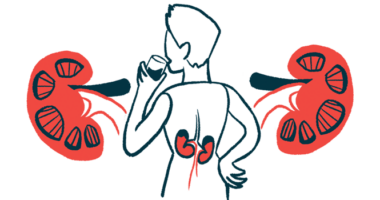Modified eye surgery effective at lessening glaucoma in hATTR
Ex-PRESS implant led to drop in use of glaucoma, blood pressure medications

A modified surgical procedure to implant a small filtration device — called Ex-PRESS — was effective at treating glaucoma in most people with hereditary transthyretin amyloidosis (hATTR), a group of disorders that includes familial amyloid polyneuropathy (FAP), a study shows.
The surgery also led to a significant drop in the use of anti-glaucoma medications. Glaucoma is a condition marked by fluid buildup in the eye, leading to increased pressure inside the eye, or intraocular pressure (IOP), that can ultimately damage the optic nerve and cause blindness. The optic nerve relays signals between the eye and the brain.
Hypotony, or low eye pressure that may reduce vision, was a common side effect of the procedure, but “all patients were properly handled, preserving the surgical outcomes,” researchers wrote.
The study, “Modified Technique of Ex-PRESS® Filtration Device Combined with a Scleral Pocket for Hereditary Transthyretin Amyloidosis (hATTR) Secondary Open-Angle Glaucoma,” was published in the journal Clinical Ophthalmology.
Glaucoma ‘is the main factor contributing to vision loss in hATTR’
Hereditary transthyretin amyloidosis is a group of progressive conditions caused by mutations in the TTR gene that lead to the accumulation of toxic clumps of the TTR protein in several body tissues.
A form of hATTR, FAP is mainly marked by nerve impairment, but the toxic aggregates can also damage the heart, kidney, and eyes — where about 10% of TTR protein is produced.
Glaucoma, among other eye problems, “is the main factor contributing to vision loss in hATTR,” the researchers wrote.
These disease symptoms are not lessened by current available therapies, including Vyndaqel (tafamidis), liver transplantation, or gene therapies, because “they have no impact on ocular TTR production,” the researchers wrote.
Most cases of glaucoma among FAP patients are now treated by surgically inserting drainage devices that allow the aqueous humor, the transparent water-like fluid in the front part of the eye, to be released, thereby alleviating IOP.
Ex-PRESS is one of those devices. Instead of a direct opening, the procedure implants a stainless steel device to establish a connection to the anterior chamber, the aqueous humor-filled space inside the eye, to allow for drainage.
This approach has been successfully used in treating open-angle glaucoma, the most common type of glaucoma that is caused by clogged eye drainage canals.
However, previous studies showed that Ex-PRESS alone was not sufficient to decrease IOP for cases where very low IOP was needed.
The ExPRESS modified technique seems to be effective, particularly when a lower IOP [intraocular pressure] is required.
Study examines data on modified Ex-PRESS surgery for hATTR glaucoma
To improve drainage in cases of severe open-angle glaucoma, a team of researchers in Portugal started to use a modified approach that creates a small pocket just below the drainage hole of the Ex-PRESS implant.
Now, the team evaluated the efficacy and safety of this modified technique for the treatment of hATTR-associated glaucoma.
The researchers retrospectively analyzed data from 32 eyes of 32 hATTR patients (50% women) with uncontrolled IOP or evidence of glaucoma progression who underwent the modified procedure and had at least one year of follow-up data.
The mean age at time of surgery was 52.1 years in the patients, who were then followed for a mean of 2.4 years. Most patients (78.1%) had undergone a liver transplant, while the remaining were being treated with Vyndaqel. Most patients had prior eye surgeries, including standard glaucoma surgeries in two patients.
Results showed that the mean IOP in patients was significantly reduced at all evaluated timepoints after Ex-PRESS treatment, from the first day post-surgery to the last follow-up. Visual acuity remained stable during the study.
This modified Ex-PRESS implant method achieved success in 22 eyes (68.8%), and partial success in six eyes (18.8%). Four eyes (12.5%) that required further glaucoma surgeries were classified as surgery failures.
Use of medications significantly reduced after surgery
In addition, the number of anti-glaucoma medications used was reduced, from an average of 3.8 medications before surgery to 0.4 at last follow-up. The number of medications to reduce blood pressure was also markedly lowered.
The most commonly reported complication was temporary hypotony, which occurred in 17 eyes (53.1%), “but only 11 (34.4%) exhibited anterior chamber shallowing and needed additional care,” the researchers wrote.
Overall, “the ExPRESS modified technique seems to be effective, particularly when a lower IOP is required,” the researchers wrote, adding that “with this novel technique, a lower number of antiglaucoma medications was necessary.”
“We believe that the presented study of hATTR glaucoma can help guide the treatment in centers where this diagnosis is less common,” they concluded.








